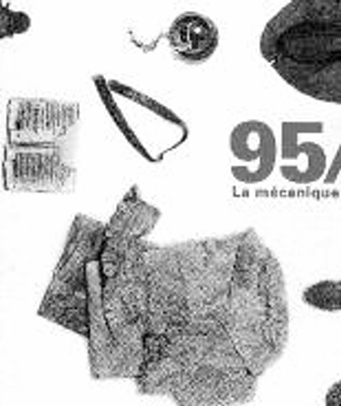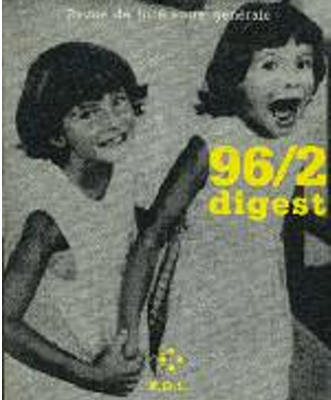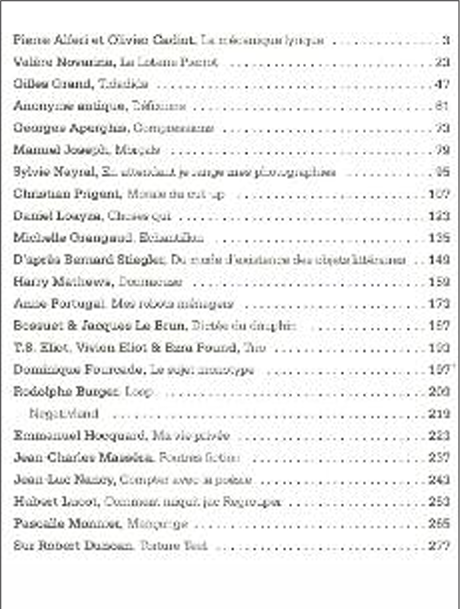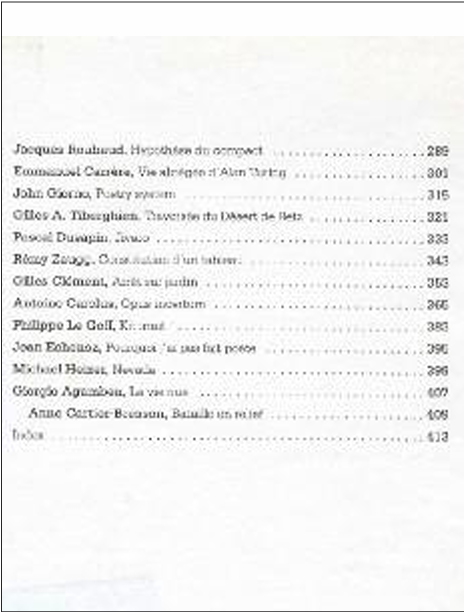
« indietro
di Jean-Jacques Poucel
 |
 |
One could describe writing like the building of a barricade, a mill or
an engine. This would constitute less than a history or an
archeology—unless it were prefaced by “once upon a time.” Of
course, it would be less than a recipe. But it could also amount to a
science fiction, an attempt to imagine and detail a worksite in the fifth
dimension of “literary space”…an expendable, fictitious theory.
– Pierre Alferi, Olivier Cadiot
La Mécanique lyrique [1]
La poésie contemporaine? While it is a perfectly imaginable category in the abstract, in some circles, the mere act of attributing a singular definite article to French poetry la poésie– constitutes anathema. Like other terrains where French cultural influence is in question, the field of contemporary literature is rife with subtle and rigorous complexities that encode historically informed pluralities. In the case of poetry, the sacrosanct mode of French literary identity, the terms of the debate have remained fraught and the stakes have remained high throughout the 20th century, and partly because, along with everything else that may be said of it, poetry is a discourse about discourse.
One need not be reminded of Stéphane Mallarmé’s “ex quise crise”– literature reflexively turning in on itself in a not-so-distant fin de siècle– nor of the influence poetry exerts on 20th century maîtres à penser to appreciate how the constitutive elements of a poem may be construed as vestiges of order, power, and politics. One need not belong to the cognoscenti of discourse critique to understand that the advent of French free verse, the new horizon that Mallarmé heralded in his Crise de vers (1895), served the same purpose for modern French poets as the advent of twelve tone music for modern composers: it destabilized the dominant melodic and rhythmic structures that mediate our experience of the world, thereby demonstrating that the deep structures underlying the grammar of aesthetics can be rethought and displaced by the self-conscious use of alternate or divergent frames of reference; in fact, such displacements enrich without replacing previous orthodoxies. And yet, students of modern French poetry will be hard pressed to find analyses of the symbolist movement that fail to define its tenets in contrast to the ideological underpinnings of realism and naturalism; or, studies of dada and futurism that overlook the international political con text of their inception and dissemination. Indeed, specters of history continue to exert formidable pressures on the way werelate to art generally, and the case of poetry is no exception.
In effect, in the process of becoming associated with movements, or schools of thought, poets often define for themselves and their readers an explicit, often shifting relation between the act of writing poems and surrounding social discourse. Surrealists, for example, first sought to dissociate poetry from ideology. They then proceeded to align their work with unbridled revolt. And, shifting again, in the midst of WWII, parted ways over how poetry should respond to the war– in the context of the German occupation Breton rejected a conservative return to traditional form, which is why, in Le Déshonneur des poètes (1945), Benjamin Péret severely dismisses the patriotic poetry of Paul Éluard and Louis Aragon. Similarly, the lettrisme of Isidore Isou, one of the less frequented mid-century avant gardes to develop a poetics based on both phonic and graphic experiment, enjoyed a first period of ample production occasionally characterized as ‘aesthetic.’ That p riod evolved into a second ‘radicalized’ moment during which original group members founded L’Internationale situationniste (1958-1969) thereafter embarking, to some extent, on Guy Debord’s scathing critique of capitalism, consumerism, and the alienating rise of media culture. In each case, as readers, we are tempted to understand the work of poets by privileging their relation to history, whether personal, esthetic or political.
After 1968, contextualizing French poetry continued to be difficult, and increasingly so throughout the 80s and 90s as more poets returned to the literary stage. With the improbable exception of the Oulipo, there is no dominant school of poetry or subset of movements that define the field. Instead, each poetic voice is forged via unique experience, particular constellations of technique, and fiercely independent stances with regards to poetic line age. Even for the members of «L’Ephémère», the influential, somewhat mainstream journal run by Yves Bonnefoy, Louis René des Forêts, André du Bouchet, and Jacques Dupin, for example, all of whom share similar, optimistic philosophies of language, it is the pursuit of individual poetic practice, not the clear definition of a shared aesthetic, that remains the driving force of invention.
In 1991, the disparity between new poetry and its readership grew to such an extent that the prestigious École Normale Supérieure saw fit to initiate a new Centre d’Études Poétiques (CÉP) which opened the floodgates for doctoral work on living poets in France (with the exception of Philippe Jaccotet and Bonnefoy, very few living poets had enjoyed that sort of critical attention in France). Around that time, Jean-Marie Gleize, one of the CÉP’s cofounders, wrote that «it is extremely difficult to pertinently apprehend what organizes this field, or constitutes it as anything other than a pandemonium of unrelated individual practices (of which recent anthologies provide but discouraging snapshots).»[2] Whereas the first half of the century can be fairly neatly delineated in now standardized terms, poetic creation after ’68 suffers from a kind of ‘crisis of crises.’
In this context, the word crisis simply refers to the furious drive toward constant renewal, whether by destruction, invention, or the reclamation of new terrain. From Baudelaire to the present, and certainly before, it is the experience of crisis, and not merely its rhetoric, that helps define poetry. Yet, in the late 20th century, as critical discourse on écriture intensifies, the sustained and overt self reflexivity implicit in each individual’s writing succeeded in effectively blurring, from many different angles, poetic practice: the extreme inward gaze– poetry talking about (the (im)possibility of) poetry– took on increasingly divergent character. Georges Bataille, Henri Michaux, and Francis Ponge disown and redefine lapoésie (written as a single dirty word), each of them refiguring the poet’s voice in radically different terms. This dissipation informing the question of poetry further contributes to the alienation of the general reader, not to mention the consternation of critics. In a gesture that reiterates the supposed primacy of criticism, Gleize attributes this Babelization to «the absence of critical analyses complex enough to account for the multifarious concerns implied in the marginalization and occultation of poetry» (A 93). The remedy, he suggests, is to «undertake a critical study of the discourses that proclaim, for poetry, its supposed ‘absence,’its struggle to define itself and to reach an audience» (A 94). Studies on the study of poetry ensued.
Reactivating issues key to the birth of écriture, professional critics (many of whom also write poems) ask what has become of the lyric after the demise of versification, the death of the author, and the ruin of the transcendental signifier. That critical debate divided contemporary poets into two broad categories: the neolyrics, whose poetics purportedly longs for singing over thinking, and the logolâtres, or language worshippers, who prefer calculated formal experiment to the spontaneous overflow of feelings.[3] Dramatically leveling a remarkably rich and varied poetic moment, this debate succeeded in bringing much needed attention to neglected works, all the while revisiting the status of the authorial subject, the historical conditions of lyrical voice, and the relationship of poetic language to the real. It is almost as if at the turn of the 21st century we are witness to the old feud, the ancients and the moderns vying for the appropriate balance of continuity and change, but instead of poets or playwrights, the pageant is staged by academics.
As the camps polarized– almost artificially– the claims made for the lyric approached hyperbole. Jean Michel Maulpoix, another cofounder of the CÉP, argued that the neolyric should affirm the mimetic and communicative functions of language, that poetry should imagine and affect change in the world.[4] As proponent of a renewed, more confessional lyricism, Maulpoix demanded that poetry resurrect the romantic poet-hero and replenish our faith in figurative imagery.[5] In contrast, Gleize posits that the literal lyric stakes its claim for realism on its resistance to poetic imagery and the fascination it commands. Citing an illustrious lineage of anti-poets that includes Arthur Rimbaud, Francis Ponge, Denis Roche and American Objectivists, he argues that a poetry resistant to metaphor and invested in language as the bare material of thought can more directly demonstrate how we come to know (in) the world. Identifying the poetic image as «the litmus test between logolatric and lyric poets», Jean Jacques Thomas and Steven Winspur state that in the current context «particular attention given to picturesque images» denotes «allegiance to neolyricism» while «a text that functions on the basis of formulas, [and] verbal concretions» contributes to the “negative supermodernity” championed by Gleize (Poeticized, 241-2). Thus, according to the camps’ most vocal polemicists, we should detect no schisms in the emotive effusion characteristic of the neolyric; nor could we expect to hear any music, see new images or find emotive transport in the formulaic experiments of contemporary language writing.
That debate– largely played out today– suffered from glaring weaknesses. First, it promoted readings that categorically assimilated writers into oversimplified and homogeneous groups. It is unsatisfactory, for example, to evoke the lyrical transport of Bonnefoy or the role of sacred of images in his poetry without underscoring the formulae that support their textual construction. Conversely, readings that describe only the objectification of language and quotidian experience in the poetry of Ponge entirely miss the historical and ethical dimension of a text like Le Savon (1967). Second, if one were to confide in the terms of the polarized debate, ascribing value to the poetic landscape would merely boil down to one’s philosophy of language: either one adopts the neolyricist’s faith in the transcendental signifier or one capitulates to the super modernist’s nihilistic investment in text as a purely performative presentation of thought itself. Like other forms of unchecked religious zeal, such absolutism leads at best to skewed judgments.
If I have exaggerated the extremity of these positions, it is, in part, to underline that each strategy reflects an ontological stance within language: the inspiration of the neolyricist would rather approximate divine incantation than Rimbaud’s possessed voyeur; the integral nudity of the literalist emerges as closer to descriptive legal language than the spare symbolism in Beckett. The contrast also highlights a salient parallel between the categorization of contemporary poetry in France and the States: that is, the confessional mode promoted by mainstream verse culture in the US may be felicitously compared to the practice of the French neolyric, just as particular voices inhabiting the literal lyric in France can be read in dialogue with strains of American language writing.
In both cases, however, the absolute currency of this division needs temperance for the particular economies of feeling and meaning in each work to be considered on their own terms. That is, if the distinction between voice-centered and form-motivated poetry seems intuitive enough, lyrisme and littéralité need not function as mutually exclusive. Rather, they represent independent points on a continuum, at times very distant one from the other, at times precisely coinciding, depending on the text’s formal sophistication and the reader’s perception.[6] In fact, folding the terms in on each other, one might even argue that lyricism– if informed by the experimental imperative, the hallmark of the modern poetic experience– is alive and well in the literal poetics of the negative modernity now associated with the work of Emmanuel Hocquard, Dominique Fourcade, Anne Portugal, Olivier Cadiot, and a host of younger poets. One might also just as productively stage a symmetrical argument, laying bare how the precise and balanced use of poetic device remains an explicit and self-conscious element in the lyricism now associated with the writings of Philippe Jaccottet, Marie-Claire Bancquart, Christian Doumet, and a smaller host of younger poets. In effect, having it both ways– fetishizing the matter and transport of song– is commonplace in more recent critical writing, pace, for example, Michel Collot’s La matière émotion (1997) or Gleize’s recuperative reading of Larmartine. In this respect, then, the opposition lyrisme/ littéralité has proved productive, generating common ground where forums and theories of contemporaneity have flourished.
While it may be too early to tell which poets will finally emerge as prescient of the dawning century, the following rule of thumb can be provisionally useful: it is in the manner a poetics inscribes within its own materiality an awareness of its communicative condition that it most powerfully articulates an encounter with its public, with its tradition. It is along these lines that we might begin imagining how the literal lyric in France, indeed some where between France and the US, is now structuring the contemporary landscape.
*
The advent of the «Revue de Littérature Générale» marks an important shift in the way savvy French writers situate poetic discourse. Not only does this journal force fully illustrate that poets refuse to think of their work in the same narrow terms as academics, it consolidates perspectives that illuminate the core of recent French language writing. Though far from representative of the long standing and influential poetry journals like «Action Poétique» and «Po&sie», or the newer «Fin», «Java», and «Nioques», the originality of the RGL resides in its théorie d’ensemble, its placing into relation a constellation of texts that indirectly substantiate a culminating moment for a literalist poetics.
Part publicity stunt[7], part metadiscursive manifesto, the two annual, large format, 400-page volumes co-edited by Olivier Cadiot and Pierre Alferi sold, as long as they lasted, for an extremely affordable 50 francs; their arrival on the scene produced an initial éclat, largely because of their size and, mostly likely, because neither issue includes any strictly poetic or narrative texts. The classical critical essay is also entirely eschewed. Instead, what the RLG provides is multiple perspectives for apprehending the extreme contemporary, eighty-two hybrid texts framed by two short essays signed Alferi and Cadiot.
The first issue launches a frontal assault on all hierarchical categories, beginning, as the subtitle La Mécanique lyrique (1995) implies, with the lyrisme/littéralité distinction sketched above.[8] In a gesture that is self-consciouslyreminiscent of Marinetti’s parole in libertà and maximum simultaneity, the editors imagine the present as a kind of science fiction where theory is most pertinent if it remains fictitious or expendable, restricted to the realm of possibility as opposed to authority. Claiming that their review «does not intend to defend certain books, nor illustrate general tendencies,» in the second issue, subtitled Digest (1996), the editors aspire only to «provide several hardy examples» designed to recalibrate our experience of the literary object, critically expunging it from the worn out assembly line of taxonomies whose sole purpose is assimilating artifacts on a register stretching from the cliché to the sublime.[9] «The stakes,» Cadiot and Alferi claim, «are anything but aesthetic in the narrow sense of the term» (Mécanique 16) and the approach is decidedly iconoclastic, explicitly motivated by a drive to denaturalize literature, to set it free as a standardized, generic object among other cultural artifacts. To this end, Cadiot andAlferi «exhibit» the anthologized texts as OVNI (objects verbaux non identifiés– a retooled version of the French acronym for UFO, objects volants non identifiés). The enigmatic quality of these ‘monstrous objects’resides in the way each of them illustrates and redefines particular formal techniques that are catalogued and cross-referenced in the index.[10]
Though extremely diverse in tone, presentation, and subject matter, each contribution may be read as an oblique poetics: Dominique Fourcade reflects on Degas’ mono types, Michelle Grangaud analyzes anagrams, Charles Bernstein reacts to Olson’s «Projective Verse,» Jacques Roubaud describes the objectivist project by way of Charles Reznikoff, and Jean-Luc Nancy considers «Count ing with Poetry.» At times, collaborators entertain a proximate relation to poetry per se, as is the case with Jean Echenoz, a novelist who recounts why he did not fashion himself as a poet, Rodolphe Burger, the philosopher-guitarist who propounds the delights of looping, and, citing another interstice between music and letters, Georges Aperghis who applies principles of compression to his multilayered compositions. Though disconcerting, the choice of texts is anything but random. A New York Police Academy entrance exam, for example, fascinates in its implicit propagation of prejudice; the context transposed, what could be more revealing of the way critics classify literature?
Broadly speaking, in privileging the material value of textual manipulations like montage, computer assisted cutups, and by connecting them to various forms of multimedia (thus extending the horizon already broadened in the typographical play of Mallarmé’s Un coup de dés or Apollinaire’s Calligrammes), the RLG stretches and generalizes the notion of literature while particularizing the transversal value of particular techne and the effects they elicit. In deed, as Agamben writes on Bataille looking at photographs of torture, we are reminded that violence and terror also designate formal limits within writing, pace, for example, Artaud’s Théâtre de cruauté; or, to cite more recent examples, Jean-Michel Espitallier and Dominique Fourcade’s responses to torture at Abu Ghraib (see «Donald Rumsfeld est un artiste contemporain» and En laisse).
In other words, though the editors avoid assigning an overtly ideological agenda to poetry itself, their critical program marshals the formal attributes of discourse into a radicalized state as cultural artifact: «May the tropes of work themselves be transformed into standardized Objects, thereby blending into, and taking action in, the ‘real’ décor, the way Jack Spicer’s Billy the Kid played on the radio» (Mécanique 16). To a limited degree, this desire to standardize can be understood as an attempt to bring poetic craft back into a more substantive or combative contact with mainstream discourses (politics, advertisement, popular music, commercial literature). The techniques featured– formatting, looping, sampling, and scanning– are familiar for they are staples of our increasingly automated lifestyles; their standardization renders explicit how the work of poets, however extreme its economy of meaning, draws on widespread quotidian gestures. In this respect, the medium is the message and the message is immediately accessible.
In addition, underlining the potentiality of a broad set of lyrical practices, shaping form itself as a mode of cultural action, also shifts the conditions for a critically assessment of the poetic landscape. Though it smacks of a short-circuited avant-garde pipe dream, a tabula rasa to make way for the new generation, the RLG articulates what has become a paradigmatic position within the extreme contemporary: the present experienced via an anachronistic interconnectivity between all modes of cultural production. «Our desire,» write Cadiot and Alferi, «is to do what is absolutely forbidden, to blend all the levels of literary culture, to collapse all the registers—the formal in the pathetic, the user’s manual in the machine, the technique in the object (the manuscript on top of the print version); to find in this positive leveling off a starting point for a kind of secular pluralism for fiction» (Mécanique 16). In this fiction of contemporaneity, Racine, Balzac, Faulkner, Freud, and Proust are part and parcel of the same moment as Doppelt, Lespiau, Prigent, Tarkos, and Tiberghien. Similarly, the sonnet, anagram, monotype, roman-photo, and ready-made are cross-pollinated with instruction manuals, crossed-out dictation, manuscript marginalia, and interpretive speculations on a short Inuktitut text. If the exact meaning of the ‘monstrous’ OVNI eludes, what persists is the imperative to approach the question of writing, the communicative aspect of its lyrical mechanisms with fresh eyes, reconfiguring the role literature assumes in cultural production.
Dehierarchizing literature, however problematic (fictitious) the notion, presupposes a critical understanding and distance with regard to language itself. The required self-consciousness (whether cast as irony, humor or other states of reflection) emerges first and foremost from an objectification of language and its tropes; once isolated, the OVNI are set into motion or process, both independently and in their placement within the broader context, beginning with their inclusion in the RLG; like any anthology, the literary journal draws a portrait, a kind of mobile installation, framing within a more or less dynamic structure the tensions that animate figures on the landscape.
Echoing the materialist critique that underlies early L=A=N=G=U=A=G=E writing, Cadiot and Alferi insist on the quiddity of their own critical terms: «We attempted to describe strange objects using a series of provisional concepts, intended less as categories than as aspect of the same matter. We should have placed an equal sign between them: ovni = blueprint = inscapes = cut-ups = standards = samples = compression. The terms themselves are nothing but a state within literary matter; they are consigned to a continuous reworking.» The metalanguage, this lexicon offered as a means of connecting the strange and surprising texts of RLG, is subject to the same constant reworking and recombination as letters themselves. In essence, the critical terms advanced by the CDLR (comité de la rédaction—the impersonal shorthand with which Alferi, Cadiot and Otschakovski-Laurens sign throughout) are in no way considered exterior to the primary matter of literature. Rather, quite like the OVNI whose relationship to normative poetry is counterintuitive, errancy within the terms encourages their replacement, their reconfiguration, and the drive to invent other critical forms that encode self-reflexivity. It is this foregrounding of recombinative work, often ludic in nature and staged in an open-source structure, that most powerfully unites the general field of literalist poetics.
Admittedly, identifying the RLG as a consolidating moment has its problems. One might well counter that other anthologies have more effectively popularized recent poetic culture in France—for example, Jean-Michel Espital lier’s anthology, Pièces détachées (2000), which has sold more that 13,000 copies, and its accompanying critical volume, Caisse à outils (2006); these books have indeed drawn considerable attention to the diversity of contemporary French poetry, including the rise of the sound-based poésie sonore. Or, one might argue that other anthologies more coherently present a sub-set of literalist poets—for example, Emmanuel Hocquard’s Tout le monde se ressemble (1995), one of four poetry collections specifically commissioned for a young audience. It is also true that even though anthologies, critical studies, and events such as readings, Internet and small press publications have helped organize the field, the most lasting contributions in contemporary poetry remain the works of poetry (books and, increasingly, recorded performances). Still, the Revue de Littérature Générale is emblematic of a new paradigm for thinking about poetry, both in conceptualizing a general ized literary object, a standardized set of lyrical techniques, and in circumscribing as literary a vast and abstract terrain from which the normative poem-object has been ostensibly excised. This «fifth dimension of ‘literary space’» not only helps the poem breathe, easing the pressures of crisis, in the words of Alferi, it faithfully reproduces (via simulacra) an encounter with the present: «Imagine a book that is ‘too’ written, overloaded with meanings and styles, quickly passing from genre to genre, all the while obses sively explicit; in the end, the task of orchestrating these supposedly fundamental notes would be the reader’s. And, should that task prove impossible, should the notes amount to more or less than a single chord, it will have been in this sense faithful to the contemporary ‘form’ of ‘experience.’»[11]
NOTE
NOTE
1 Pierre Alferi and Olivier Cadiot, La Mécanique lyrique, «Revue de Littérature Générale» 1 (1995) 3. Subsequetly cited as Mécanique. All translations are mine and emphases appear in the original.
3 See Jean-Jacques Thomas and Stephen Winspur, Poeticized Language: The Foundations of Contemporary French Poetry (University Park, Pennsylvania State University Press 1999) p. 239.
5 See Jean-Claude Pinson, Habiter en poète (Seyssel, France, ChampVallon 1994); Jean-Michel Maulpoix, La Poésie malgré tout (Paris, Mercure de France 1996).
6 The sliding scale of difficulty might be epitomized in comparing the (lack of) formal complexities in the work of Mary Oliver and Marie-Claire Bancquart, both lauded representatives of subject based poetics; like in political attitudes, what’s considered mainstream in France would translate to a more radical idiom in the American context. See, for example, Énigmatiques (Paris, Obsidi ane 1995) and The Leaf and the Cloud (Cambridge, Da Capo Press 2000).
7 By Sponsoring this project, Paul Otschakovski-Laurens, owner of the Edition POL where many of the featured writers are published, again confirmed his considerable editorial prowess and investment in experimental literature; the hubbub with which the RLG was greeted in France garnered added exposure for the new generation of writers.
 |
 |
8 In the introduction to the first volume, that distinction is explicitly alluded to as utterly comical:«The end of poetry: already an old story…yet it is still the order of the day, and the discussion has turned farcical. On the one side, the fetishistic artist, protectors of forms & know-how. On the other, the ex-iconoclasts who are either reworking a ‘modernist’ fate or remaking themselves in ordinary prose» (Mécanique 22). But the post-face of the second makes clear that what is lost in the poetics of neolyricism is the sustained critical attention that French thinkers such as Blanchot, Derrida and Deleuze have invested in key and lasting textual tropes:«The generative energy of l’ecriture has so often been thought through in negative terms that it has elaborated a sort of vulgate of ‘lack’ now proper to literary France. There has been a re-injection of transcendence, of mystery and of piety, via deviation in great negative concepts that were rigorously elaborated in various contexts (l’impossible, la limite, l’innommable). Falling short of the force and pertinence that made these concepts, the vulgate of ‘lack’ reduced them to a single grandiloquent set of themes, thereby recreating an illusionist’s scene of writing.» (Digest 49).
9 Pierre Alferi and Olivier Cadiot, «Digest» «Revue de Littérature Générale» 2 (1996) p.49. Subsequently cited as Digest.
10 The 48 techniques catalogue dare listed as infinitive verbs in alphabetical order (e.g. automatiser, bricoler, compresser, dériver, exposer, fétichiser, formater, programmer, standardiser, transposer, zoomer); just one of these techniques gives as page reference the entire first volume (index excluded): déhiérarchiser.
11 Pierre Alferi, “Politique,” http://www.remue.net/cont/alferi4.html, Oct. 24, 2006.
¬ top of page






